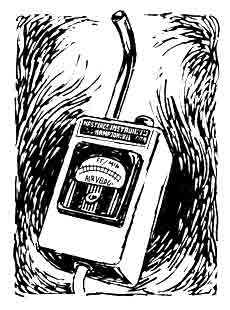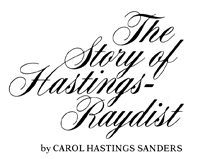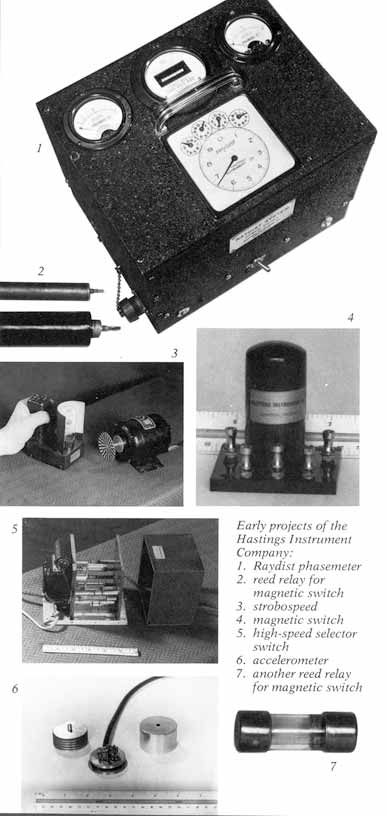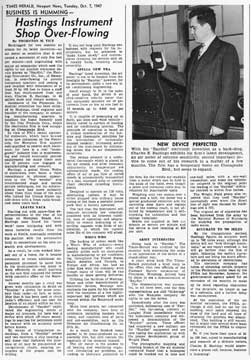T
he Hastings Instrument Company now had a string of successful projects behind it. In addition to the Raydist set sold to Wright Field and the three items turned over to Stevens-Arnold, it had developed a magnetic switch and coil for the Naval Research Laboratory, a maximum recording accelerometer for the Cornell University Medical College (which was hoping to find a way to detect brain tumors by careful measurements of the acceleration of the head), and a visibility meter for the Signal Corps of the U.S. Army.
Other projects were in various stages of experimental development—a frequency meter, a strobospeed, a vapor detector, and an Air-Meter.
Sales had progressed from zero in 1944, to $4112 in 1945, to $12,317 in 1946. Although the company was still not running at a profit, Hastings thought that it soon would be.
Up to now, the company had been run with the idea that it would not do general manufacturing. Some instruments were developed as one-of-a-kind items for a special purpose, and others, with more commercial potential, were developed with the idea of licensing their manufacture to other companies.
But Raydist didn't fit into either category. Although Hastings believed that Raydist's potential was enormous, he could see that it needed years of development. It wasn't at all like the magnetic switch, which had been developed into its final form very quickly and then sold off. Developing Raydist on his own would require a lot of money, and a lot of money was something he didn't have. Yet there was a way around this problem. Raydist was applicable to many military uses, and the military often awarded development contracts for apparatus it needed. If he could win some of these contracts, the development of Raydist would be paid for as part of the deal.
To win these contracts, a company had to be an ongoing, stable concern—not just a single-handed operator working on a shoestring out of his garage. It was time to incorporate the company, raise some capital, and become a sizeable company worthy of more notice and larger contracts.
Hastings decided that the incorporated company would try out manufacturing, beginning with the Air-Meter and continuing with other instruments as they became ready. It would also seek Raydist development contracts, and work toward the day when it could manufacture Raydist for general commercial use.
N
ow that it looked as if the company might actually become successful, it was time to arrange how the people who had worked so many hours for the last two and a half years would be rewarded.
In the past, the pay at the Hastings Instrument Company had been considerably less than the market rate. A few had worked with no compensation at all, and the rest had been paid a dollar an hour—this at a time when experienced engineers were making in the neighborhood of $2 to $3 an hour. There was a general understanding that if the company prospered, everyone would reap benefits later; if it did not, they had at least learned a lot and had had some good times.
The corporation would be set up with 3500 shares of stock. Half would go to Charles Hastings in exchange for all the patent rights and the good name of the Hastings Instrument Company. Another 545 shares, or 16 per cent, would be divided among the eleven men who had put in so many hours: Charles Hastings, James Benson, Andrew Hacskaylo, Arthur Samet, Albert Budde, Raymond Hansen, Harry Ricker, Jr., Hugh Watson, Jr., Thomas Carpini, Sumner Besse, and Emmanual Schnitzer. The rest of the stock—34 per cent—could be sold later for cash, as needed.
In addition, the eleven agreed to turn over $10,900 in cash and equipment to the corporation in exchange for notes. The notes paid 4 per cent interest, and would be paid back whenever the company chose to do so. If the company did not do well, they might never be repaid.
The corporation received its charter from the state of Virginia on Valentine's Day 1947, a Friday. The following Monday evening, everyone gathered at the Hastings home. The eleven stockholders chose eight of their group to be on the board of directors: Charles Hastings, Mary Hastings, Andy Hacskaylo, Arthur Samet, Jim Benson, Al Budde, Harry Ricker, and Ray Hansen. The directors in turn chose the company officers: Charles Hastings as President, Mary Hastings as Vice-President, and Arthur Samet as Secretary-Treasurer.
F
or all the formalities, it was in many ways just the same company as it had been the week before. Charles and Andy were the only ones who worked full time, and the place of business was still the Hastings home. But big changes were about to come.
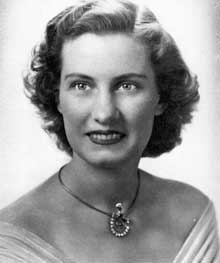
Mary Hastings
|
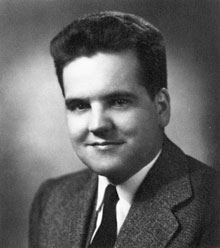
Charles Hastings
|
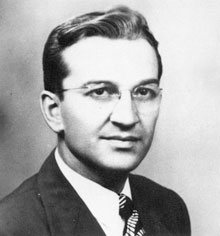
Andy Hacskaylo
|
By mid-April, after much talking and prodding, Charles and Andy had just about convinced the Signal Corps to give HICO a $40,000 contract to build a two-dimensional Raydist set. The set would be used to calibrate radar landing systems. To finance the project, Hastings was hoping to get a bank loan of $25,000.
It was clear that he needed to find a banker with vision. If the banker's only concern were the current balance sheet and income statement, he wouldn't give the Hastings Instrument Company a second glance. Sales so far in 1947 were zero, and the books showed a deficit of $4130. Theoretically there were assets of $53,804, but the bulk of this was "experimental Raydist equipment," listed as worth $13,061, and "patents and designs," listed at $33,541. Assets like these were of no value to bankers. Getting the loan depended on Hastings being able to persuade a banker that HICO could perform the contract.
Fortunately Charles Hastings had a marvelous ability to sell himself and to convince people of the future of his equipment.
He approached Harvey Wilson, president of the Bank of Phoebus, where he did his personal banking. He also approached Glenn Roy, vice-president of the First National Bank of Newport News, which had loaned him the $4000 for the Wright Field job. Both men were impressed, but neither wanted to undertake that large a loan single-handedly. Eventually they worked out an arrangement whereby the First National Bank would make the loan, with the Bank of Phoebus as associate bank. Hastings had to assign the contract to the bank, as well as pledge all company and personal assets to back the loan, but HICO got the loan it needed.
The next hurdle was to impress the contracting officer who was sent to Hampton in early May to take a first-hand look at the company. The Army didn't hand out a contract that large without examining the company to see if it were technically and financially able to handle the job.
The visit presented a problem. In seeking the contract, Hastings had considered it prudent not to mention that his company was staffed with part-time help. Now he wondered what would happen if the contracting officer came to the Hastings home to tour the business and found there only Charles, his wife, two children, and Andy Hacskaylo.
Something had to be done to spruce up appearances. On the day the officer was to make his visit, the children were sent off to stay with their grandparents and all the part-time employees took the day off their regular work and came over to the Hastings house. When the officer arrived, the place was bustling with activity. The officer was impressed. In technical matters, the company appeared to be competent.
Next the officer wanted to see how the employee records were kept. Arthur Samet was happy to show him the records of a "typical employee," and carefully arranged it that each item the officer saw—whether it was a time card, pay record, personnel record, or whatever—was that of Andy Hacskaylo, the company's only full-time employee other than Charles.
By this time the company's financial position was a moot issue, since the bankers had already agreed to back the contract financially. Nevertheless, the officer asked to see a current financial statement, and Samet obliged. The man looked it over, then commented, "This is a terrible financial statement!" Samet smiled and candidly replied, "I can't help but agree with you."
The contract received final approval.
M
eanwhile Hastings and Hacskaylo were busy demonstrating Raydist to as many others as they could.
They developed a standard format for guests who came to Hampton. First, Hastings would give a brief talk, summarizing Raydist's development, explaining its potential uses, and listing its advantages. Then the group would go out for a demonstration at the straight stretch of highway along Pembroke Avenue where Charles and Andy had previously painted white marks every 100 feet.
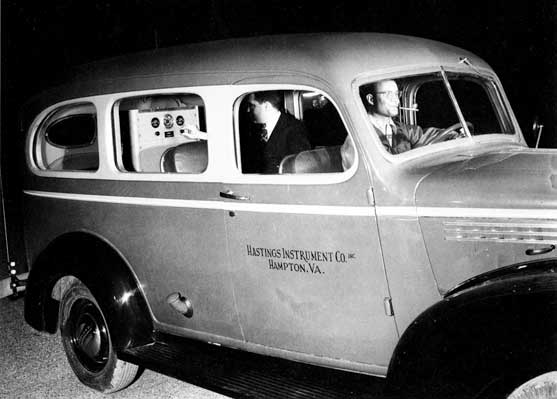
For demonstrations, Raydist equipment is set up along major highways and in the company's station wagon. Here, Charles Hastings sits in the back seat, watching the phasemeter of a Raydist master station during a test.
|
For a hyperbolic demonstration, two transmitter stations were set up a mile apart along the road; for a range demonstration, a transmitter was carried inside the station wagon and a single relay station was put on the highway. They demonstrated the system by driving down the highway, taking Raydist dial readings at every 100-foot mark. To test the hyperbolic radiation pattern, they drove between the transmitters on Pembroke Avenue, then crossed over to Shell Road for the return trip. (See Appendix: How Raydist Works.)
Other demonstrations were held around the country, wherever a prospective customer could be found.
An especially dramatic demonstration was given in mid-April at the Naval Training Center in Patuxent River, Maryland. They put a coin on the road, took a dial reading with the coin at the edge of the front tire, and backed the station wagon up several hundred feet. Then with a man from the Navy Bureau of Ships sitting in the back of the station wagon watching the Raydist dials, they slowly drove forward, stopping the moment he told them they should be back at the coin.
When they got out of the wagon and looked for the coin, it was nowhere to be found. Either the Raydist equipment had performed so badly that they had missed the coin entirely, or it had performed so perfectly that the coin was under the tire. They moved the station wagon forward a foot and looked again. There was the coin!
Based on this success, the Hastings men were asked to make a demonstration in May at the Bureau of Ships headquarters in Washington, D.C. This demonstration also went well, and within a few weeks, the Hastings Instrument Company received a contract for its second two-dimensional Raydist set. This one would be used for laying mines at the Naval Mine Countermeasures Station in Panama City, Florida. Like the earlier jobs, it was a straight fixed-fee contract to produce an end result. If HICO didn't produce the result, it wouldn't get paid.
W
hile some were busy with Raydist, others worked on the Air-Meters. One of the first actions of the newly incorporated company had been to order the parts to construct 100 Air-Meters. By summer, completion was fairly well along, and it was time to calibrate them. Again they relied on Pembroke Avenue, which by now had become as familiar a work place as the Hastings home.
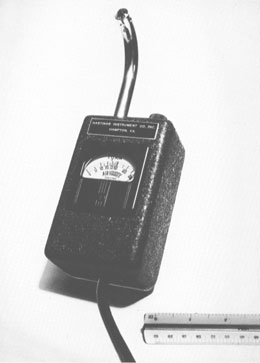
An early Air-Meter, with hand-lettered dial face.
|
Calibrating an Air-Meter required two people. On a typical trial, Mary Hastings would drive along the highway, steering with her right hand and holding a probe out the window with her left. Ray Hansen would sit on the front seat beside her, watching the Air-Meter, waiting to record speeds on its blank dial face. Mary would glance down at her speedometer and say, "All right, we're now going five miles an hour." Ray would put a mark on the scale where the needle was.
Again and again they would go through the same procedure, at 10, at 15, and 20 … , checking and rechecking. At the end of the test, they would return to the house and neatly letter the dial face.
After the Hastings people had calibrated several instruments this way, they rigged up their own wind tunnel using a tank-type vacuum cleaner plugged into a Variac, a variable power transformer. Using their already-calibrated Air-Meters, they calibrated the air flow through the vacuum cleaner's hose, and then used the vacuum cleaner system to calibrate future Air-Meters. Years later, they compared these early calibrations with more sophisticated measurements and found them remarkably accurate.
O
perating the corporation from the Hastings home was becoming more and more unworkable. The board of directors had appointed a building committee to find a new location, but it was a difficult job. There was very little available in 1947, so soon after the war. Also, it didn't help that the lack of suitable buildings in the community was equalled by the lack of funds in the corporate treasury.
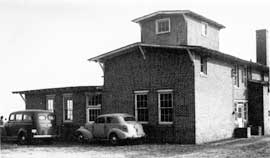
HICO's new quarters at 1610 Chesapeake Avenue.
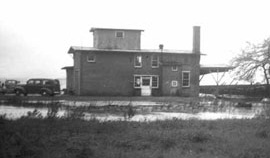
Flooding was a problem, but at least the company had more space than it had had in the Hastings home.
|
As the search for a location dragged on, it became clear that working out of the Hastings home simply could not continue. By now there were seventeen people working elbow to elbow at 117 Hampton Roads Avenue. If the right location could not be found, they would just have to settle for a temporary location where they could work until a better place turned up. They found a building at 1610 Chesapeake Avenue known locally as "the old brickyard." Once the home of a brick distributorship, it was now vacant and for lease, cheap.
Cheap for good reason, for the roof leaked, and at spring tides the water on the floor was several inches deep. But at least it had more space than the Hastings home, and it would look more impressive to clients.
After several postponements, moving day was set for Friday, July 11. Charles Hastings declared that the move would take place on that day "come hell or high water." He got the latter. A major storm coupled with spring tide brought such high water to the Hampton area that the National Guard was called out to rescue residents from their flooded homes. At the same time the Hastings employees were wading into their new building, carrying their equipment.
It didn't take many rains before they knew each leak in the roof and had placed a bucket at all the strategic locations. Plenty of mops were on hand to clean up after each flood. The cardinal rule of operation was that no equipment could ever be stored on the floor.
M
oney was a critical problem in those first months, and continued to be for several years. In addition to needing loans for major contracts, the company needed additional money for everyday working capital.
In April 1947 the company raised $2000 by selling 100 shares to people within the company, and made plans to sell 400 more shares at $30 each to the general public. Since the corporation was restricted by Virginia law to thirty stockholders until such time as it had paid out dividends from earned income for three consecutive years, it was agreed that a minimum investment for the public sale would be 34 shares, or just over $1000.
The job of promoting the sale fell to Andy Hacskaylo, who went around the community collaring prospects and making pitches. Although he was turned down in some cases, he also found receptive ears. Two such ears belonged to Dr. Chester Bradley, who commented to him, "Andy, Henry Ford started out with nothing. This thing here could be the same sort of company." That was the type of response Andy liked.
By fall all 400 shares had been sold.
In addition to setting up a stock sale to the public, the company set aside 350 shares that employees could buy at a 10 per cent discount. Each employee could buy up to three shares each quarter. The program was popular, but had to be discontinued a year later: the number of company employees grew so rapidly that continuing the program would have put the total number of stockholders over the legal limit of thirty.
A
s if all this weren't enough to get the corporation off to a rousing start, Hastings Instrument Company was getting a lot of attention from companies interested in using Raydist for oil prospecting in the Gulf of Mexico. These companies had been experimenting with Shoran, radar, and other methods of radio location, but had found nothing sufficiently accurate.
In the spring and summer of 1947, Hastings made demonstrations to representatives of several oil companies and geophysical survey companies. One contact looked especially promising: Seismograph Service Corporation of Tulsa, Oklahoma, one of the nation's largest geophysical survey companies.
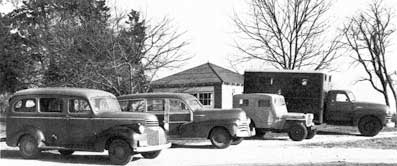
HICO's fleet of vehicles, 1948.
|
The negotiations with Seismograph Service resulted from a demonstration made in April 1947 to representatives of Phillips Petroleum Company. Hastings had demonstrated to them both the single-user, range type of Raydist, and the multiple-user, hyperbolic type. They liked the latter, and were convinced that Raydist was the solution to their offshore survey problem. Since Phillips had been contracting its geophysical survey work to Seismograph Service Corporation, it told Seismograph about Raydist. On May 15, at the request of Seismograph, its Executive Vice-President came to Virginia to meet with Hastings. They discussed the Raydist system and how it might be used in offshore oil exploration. A week later Hastings received a letter formally proposing that Seismograph Service Corporation and Hastings Instrument Company form a joint venture.
In mid-June Hastings went to Tulsa to discuss the joint venture. During these talks, he mentioned that there was a significant patent which anticipated his Raydist system, and that he had already opened negotiations for these patent rights. Although he didn't disclose the name or number of the patent, or the inventor's name, he was referring to a 1938 patent held by a French inventor, E. A. H. Honoré.
Negotiations continued on through the summer. When Seismograph asked Hastings to arrange another demonstration for the Phillips representatives, Hastings scheduled it for September 8. Shortly before that date, Hastings Instrument Company received a telegram from Seismograph: DUE UNEXPECTED IMPORTANT TRIP BY CLIENT'S REPRESENTATIVE, UNABLE BE THERE FOR DEMONSTRATION MONDAY. WILL INFORM YOU LATER SUITABLE DATE.
In the weeks that followed, Hastings heard nothing. When he tried to reach Seismograph by telephone, he was told that everyone he wanted to talk to was "out of town." Eventually he learned that he wouldn't be able to get the rights to the Honoré patent after all—Honoré had made an exclusive deal with Seismograph.
The whole affair had been a big disappointment. The high hopes he had had in May for a joint venture had come to naught.
If he had known more about Seismograph's actions, he would have been not just disappointed, but outraged. But it would be several years before the full story of those negotiations would come to light.
About this time prospects for Gulf work dimmed considerably anyway. The states and the federal government were arguing about which of them could issue leases for oil drilling in the Gulf. Until the issue was settled, few oil companies were interested in exploring the tidelands.
B
y the end of the year, Hastings was happy with the progress that had been made. The first 100 Air-Meters had been sold by October, and only one had been returned as defective. More were being produced. The delivery of the Raydist set to the Signal Corps had been postponed from October until early 1948, but the set for the Bureau of Ships had been delivered and was working perfectly.
According to the income statement, the corporation had made a loss of $9500, but the loss was actually more apparent than real. The book value of the patent rights originally listed as worth $35,000 were being written off over five years, which meant almost $7000 was charged off in 1947. In addition, the income was artificially low because of the postponed delivery of the Raydist set for the Signal Corps. Since the contract hadn't been completed in 1947, the equipment was carried on the books only as work-in-progress inventory—there was no way to show on the books that part of 1947's overhead expenses would be paid for when the contract was completed. With these two facts in mind, Hastings knew that the company had had a successful year despite the stated loss.
Sales for the year were $42,229. Of that amount, the sale of the Raydist set to the Bureau of Ships came to $37,202, or 88 per cent. The message for the future was clear. It was imperative that the company maintain a backlog of jobs. The survival of the company demanded a continuing series of contracts that could dovetail together.
By the spring of 1948, prospects were bright. Several Raydist contracts were in the works, the Air-Meters continued to sell well, several new instruments were about to be introduced, and a possible permanent location had been found. A building containing over 14,000 square feet, located on 39th Street, was available from Horne Brothers, Inc., for $55,000, with $15,000 down and a ten year mortgage. The board of directors voted to buy it, and to raise the down payment by selling additional stock at $60 a share.
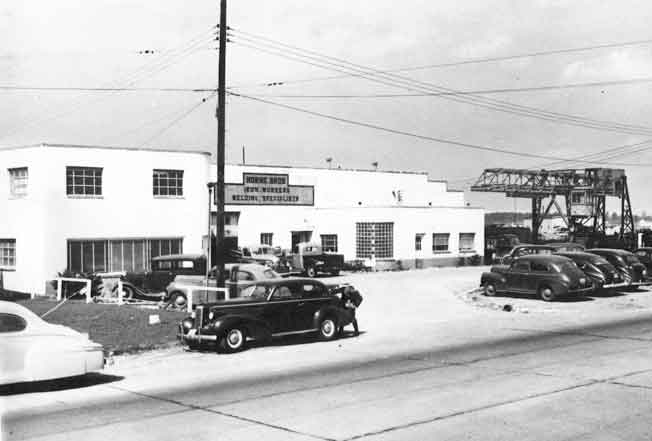
The search for a better location leads to the building of Horne Brothers,
a sheet steel welding company that specializes in boat repair.
|
T
hrough the years Hastings had kept in touch with his childhood friend Ray Doyle, who was still living in Baltimore. Doyle had been working for Western Electric for six years, accumulating experience in many areas, including expediting, warehousing, personnel, and security. Charles and Mary went to Baltimore every now and then to visit Charles's parents, and they usually took the opportunity to spend an evening talking with Ray and his wife Ellen.
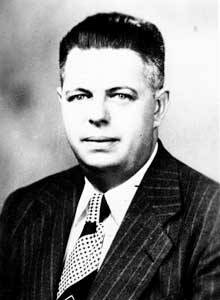
In 1948 Ray Doyle joins HICO as production superintendent.
|
In April 1948 Doyle received a call.
"Ray, this is Charlie. I'm in Baltimore. Are you busy this evening? I've got something I want to talk to you about."
"Come on over. We'd love to have you."
Soon Hastings arrived, bringing with him an oversized briefcase, obviously filled.
"I've got a big government contract," Hastings told him. "We're going to be expanding enormously and I'd like your advice."
Hastings opened his briefcase and pulled out a diagram of the new building. "I've lined up this as our new building and have to decide how to lay it out."
He described the operations the building would have to accommodate.
Doyle studied the diagram, then began making suggestions. "You could put your stockroom here," he said, beginning to point out locations, "a mechanical shop here, and an electronic shop here. From what I see the obvious place for the engineering is over there …"
Later the subject turned to the new people who would be hired. Part of Doyle's personnel work had required him to know what background an employee had to have to handle various jobs, and he knew what to look for in hiring the personnel Hastings would need.
"And another thing," Hastings continued. "I've got to put guards on around the clock. How do I do that without getting into overtime pay and give every guard two days off a week?"
"That's easy," Doyle told him, reaching for a piece of paper. "I've worked with that here." He quickly drew a block diagram showing how it was done.
After the discussion had gone on for several hours Hastings got to the point: "Ray, why don't you come down and handle all this for me?"
The next morning Charles's father looked at him sternly, waiting to hear what his son had done. He had known what Charles had in mind when he went over to see Doyle the night before. Still skeptical about his son's business venture, he had spoken to him severely, "Charles, Ray has a wife and family and a good job with Western Electric. Don't you go out and talk that boy into moving down to Virginia to work in your wild schemes."
"Ray and Ellen are going to come down and take a look before they make a decision," Charles told him.
A month later Ray Doyle reported to work at the Hastings Instrument Company. His title was "production superintendent" and he was in charge of personnel, security, purchasing, and all the shops.
T
he agreement with Horne Brothers allowed HICO to begin moving into its new quarters during May. Horne would not be completely out until September, so throughout the summer the Hastings Instrument Company worked side by side with the clamor of handling and welding large sheets of steel. But the summer passed, and by fall HICO had the building all to itself. The building on Chesapeake Avenue was kept for field tests until mid-1949. After that, field tests were run using large trucks, or "mobile labs."
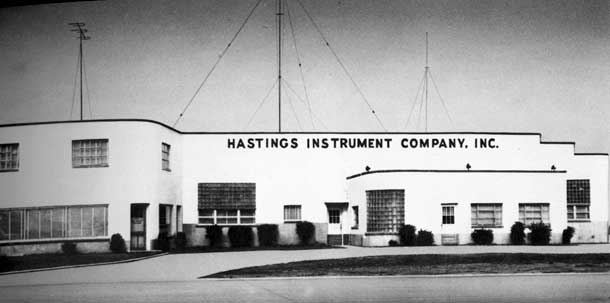
Hastings Instrument Company moves into its new quarters on 39th Street during the summer of 1948.
|
Early in 1949 Horne Brothers offered to sell the mortgage to HICO for $35,000, a substantial discount. It looked like a good deal, if only the company had the money. Although HICO was unable to put up that kind of money, Hastings put together a group of investors to buy the mortgage—the principal one being his father. The senior Mr. Hastings was slowly gaining confidence in his son's business, and decided that putting money into a mortgage was a wise investment.
T
he number of employees grew rapidly. By the end of 1948 there were 75, and by the end of 1950 there were 118. Financially the company was getting on its feet. Sales spurted from $42,000 in 1947 to $435,000 in 1950. From a loss of $9500 in 1947, the company now began posting solid profits of $20,000 to $30,000 a year.
But the company's cash position during those years was often a bit precarious.
HICO's biggest customer, the Navy, was aware of the company's financial position. Recognizing the importance of the HICO work, the Navy made progress payments every two weeks to help the company meet its payroll. Occasionally the payment didn't arrive on time. In those cases the company was able to pay the regular employees, but not the officers. The officers had to wait for their paychecks until the Navy check arrived.
In mid-1949 a financial squeeze caused a more serious disruption. Charles Hastings expected to receive several military contracts as soon as the 1949-50 Military Appropriations Bill was passed in Congress. Passage of the bill was routine, he was told. Wouldn't he go ahead and get started?
Hastings naively went ahead and began work on the contracts. As it turned out, there was a big fight in Congress over this bill, and passage was delayed about two months. Meanwhile, Hastings Instrument Company had no way to pay the people working on these contracts, and had no choice but to lay off seventeen employees—almost a quarter of its work force.
The bill eventually passed, the contracts were awarded in early September, and the employees came back to work. It had been a painful lesson in just how hand-to-mouth the finances of the company were, and Charles Hastings would never forget it.
By the end of the year, however, the cash balance was in better shape, and the Hastings Instrument Company declared its first dividend, $1.80 per share.
T
he lion's share of the work during these years was Raydist equipment developed for the Navy Bureau of Ships and Bureau of Ordnance. Typically the contracts were negotiated on a cost-plus-fixed-fee basis. The additional paperwork for these contracts, plus the tight security that the Navy insisted on, turned the company from a low-overhead operation to a high overhead one. The new procedures were at times frustrating, but as long as the Navy was willing to pay for the extra overhead and security, Hastings believed he would come out all right. Besides, as he confided to an employee who complained about some of the procedures, "It is the only possible means to fully develop Raydist without the unlimited capital which we both know I do not possess."
One of Hastings' goals was to develop a line of Raydist for commercial use. In 1950 he reached this goal by selling his first standard set to the Norfolk Corps of Engineers. Used for hydrographic surveys and channel dredging, the set performed well, and provided Hastings a stepping-stone to further hydrographic work.
An especially rewarding job, because of the publicity it brought to Raydist, was the development of an automatic plotting board for the Navy. Since the Navy had no objection if others were invited to the demonstration of the finished product, Charles and Mary decided to invite both the press and all the admirals and generals they could get together from the whole East Coast. The big occasion was set for August 8 and 9, 1949.
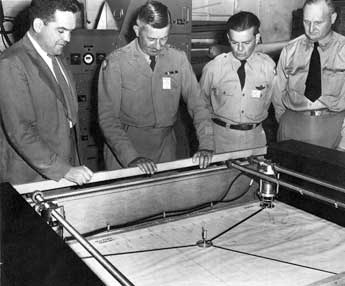
Hastings (left) and military officers watch the automatic plotting board as Raydist traces the path of a ferry from Old Point Comfort to Willoughby Spit.
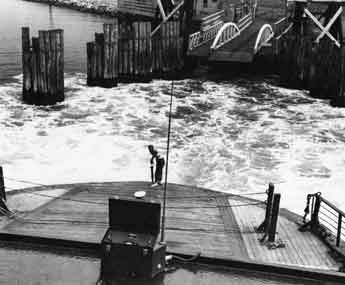
Ferry carrying Raydist transmitter docks at Willoughby Spit. The Raydist transmitter and its antenna are in the foreground.
|
A Raydist transmitter was put aboard the ferry that went from Old Point Comfort across Hampton Roads to Willoughby Spit. At the HICO plant, the plotting board was set up at one end of the room and the speaker's platform at the other. With a chart of the area mounted on the plotting board, the visitors could watch as Raydist tracked the movements of the ferry going back and forth across the channel.
On the first day, shortly before the demonstration was to begin, one of the Raydist engineers noticed that something was wrong. According to the plot made by the Raydist, the ferry sometimes missed the dock! Usually the recording showed the ferry coming into the slip perfectly, but every once in a while something went haywire.
Although no one knew what was causing the trouble, everyone knew that a demonstration that showed the ferry making a crash landing would bring less than optimal publicity.
Since it was too late to postpone the demonstration, Charles Hastings decided to finagle. Every time the ferry started out across Hampton Roads, he herded all the visitors to the plotting board to watch. As the ferry neared the other side, however, he called everyone back to the other end of the room to hear someone talk about one aspect or another of the system. It was a difficult operation to maneuver without bullying. The spectators were very eager to watch the ferry come into the slip, and Hastings was determined that they wouldn't. Fortunately, Hastings typically won out, and in those instances where he didn't, the equipment behaved itself.
The military brass were suitably impressed and the press sent out an AP story and wirephoto that were picked up all across the country.
After it was all over, a relieved HICO crew took their guests out to dinner. Meanwhile one Raydist engineer stayed back at the plant to find out what had been going wrong. By the time the others returned, he had the answer for them. Their demonstration had come within an eyelash of being ruined by a slipping gear that needed only to be tightened.
A
lthough its sales were tiny compared with those of Raydist, the line of "Hastings instruments" was growing. By 1950 it included the original Air-Meter, a Precision Air-Meter (for higher ranges and more accurate readings), a maximum indicating accelerometer, a voltage regulated power supply, an electronic standard cell, and most important, a vacuum gauge.
The vacuum gauge was based on the same basic principle as the Air-Meter—a heated thermopile. The Air-Meter worked because a higher wind cooled the thermocouples more rapidly than a lower wind. Likewise, the vacuum gauge worked because a lower vacuum cooled the thermocouples more rapidly than a higher vacuum. (See Appendix: How the Hastings Thermopile Works)
In addition to the commercial line of instruments, HICO developed specialized instruments for specific customers. For example, a probe to measure ventilation in clothing was developed for the U.S. Army Quartermaster Corps. The "ventimeter" was part of an Army project to develop clothing that would keep wearers comfortable under extreme weather conditions.
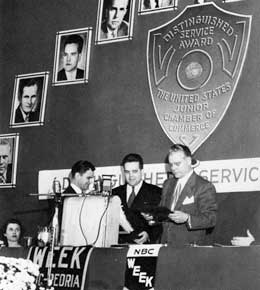
Charles Hastings (center) receives his award as one of the nation's Ten Outstanding Young Men of 1949.
|
F
or years, Hastings had been waiting for his Raydist patent to issue. Since his "radio ground speed system" had been classified until the end of World War II, the patent office did not get started on his application until 1945. Then there were many delays. Finally, in 1950, ten years after he first invented the system, the Raydist patent was issued. Within a few months, he would also have a patent on his Air-Meter.
For Charles Hastings, the highlight of 1950 was being chosen by the United States Junior Chamber of Commerce as one of America's Ten Outstanding Young Men for 1949. The Ten Outstanding Young Men program had begun in 1938, and every year hundreds of nominations were submitted by local Jaycee chapters, universities, and government agencies. Many distinguished men had won the award—such as George Gallup, Orson Welles, Edwin Land, and Henry Ford II—and Charles Hastings was proud that his name now had a place on that list.
next chapter >>
Copyright © by Carol Hastings Sanders
|
